语言学-形态学
- 格式:ppt
- 大小:203.00 KB
- 文档页数:24
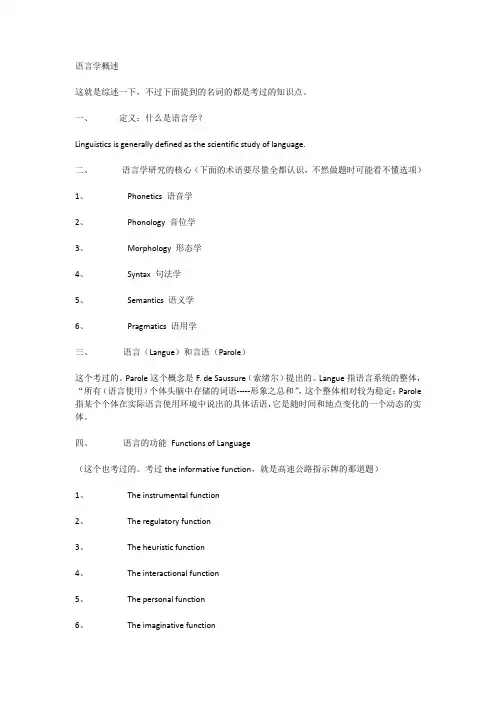
语言学概述这就是综述一下,不过下面提到的名词的都是考过的知识点。
一、定义:什么是语言学?Linguistics is generally defined as the scientific study of language.二、语言学研究的核心(下面的术语要尽量全都认识,不然做题时可能看不懂选项)1、Phonetics 语音学2、Phonology 音位学3、Morphology 形态学4、Syntax 句法学5、Semantics 语义学6、Pragmatics 语用学三、语言(Langue)和言语(Parole)这个考过的。
Parole这个概念是F. de Saussure(索绪尔)提出的。
Langue指语言系统的整体,“所有(语言使用)个体头脑中存储的词语-----形象之总和”,这个整体相对较为稳定;Parole 指某个个体在实际语言使用环境中说出的具体话语,它是随时间和地点变化的一个动态的实体。
四、语言的功能Functions of Language(这个也考过的。
考过the informative function,就是高速公路指示牌的那道题)1、The instrumental function2、The regulatory function3、The heuristic function4、The interactional function5、The personal function6、The imaginative function7、The informative function五、语言的普遍特征Design Features这个也考过的,这五个特征由美国语言学家Charles Hockett提出。
弱弱地说一句:如果真的在临时抱佛脚,那就不要管这五个术语的具体含义了,只要能强行记下来应付考试就是了。
>_<1、Arbitrariness 任意性2、Productivity 多产性3、Duality 双层结构4、Displacement 移位性5、Cultural Transmission 文化传播性六、语音学和音位学(一)语音学Phonetics: the study of the phonic medium of language.1、三大分支(1)Articulatory Phonetics发音语音学(2)Auditory Phonetics 听觉语音学(3)Acoustic Phonetics 声学语音学2、辅音和元音(这个考过的,考过二者的区别)(二)音位学Phonology: aims to discover how speech sounds in a language form pattern and how these sounds are used to convey meaning in linguistic communication.1、三个术语(1)Phone音素(2)Phoneme音位(3)Allophone音位变体2、Suprasegmental Phonology超音段音位(考过的)包括Stress重音、Tone音调、Intonation语调七、形态学Morphology: refers to the study of the internal structure of words, and the rules by which words are formed.(一)两类词汇1、Closed class words封闭性词汇2、Open class words开放性词汇(二)Morpheme词素1、Free morpheme自由词素2、Bound morpheme粘着词素3、Stem词干4、Root词根(三)Word-formation构词法(四)Inflection屈折变化八、句法学Syntax: studies how words are combined to form sentences and the rules that govern the formation of sentences.九、语义学Semantics: is generally considered to be the study of meaning in language.1、Synonymy同义关系2、Polysemy一词多义3、Homophones同音异义&Homogragh同形异义&Complete homonyms同形同音异义4、Hyponymy上下义关系5、Antonymy反义关系6、Analysis of meaning语义分析(1)Componential analysis成分分析(2)Predication analysis述谓分析7、Two-place predicate二向谓词、one-place predicate一向谓词、no-place predicate 零向谓词8、Sense relations between sentences(1)Entailment(2)Presupposition十、语用学1、Pragmatics: the study of how speakers of a language use sentences to effect successful communication. (Or it refers to the study of natural language understanding, and specifically the study of how context influences the interpretation of meanings.)2、区分语义学和语用学的最本质因素是:是否考虑了语言使用过程中的语境。
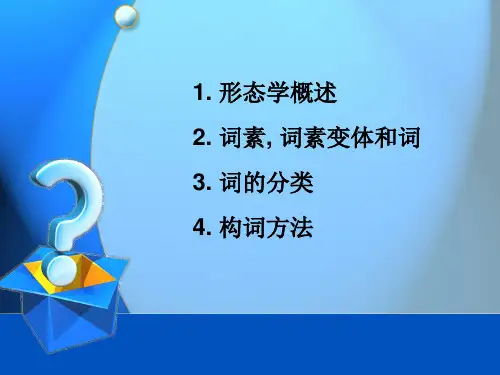
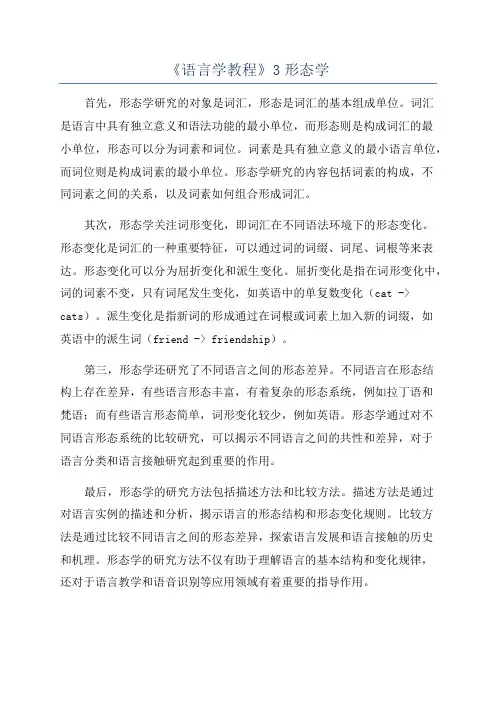
《语言学教程》3形态学首先,形态学研究的对象是词汇,形态是词汇的基本组成单位。
词汇是语言中具有独立意义和语法功能的最小单位,而形态则是构成词汇的最小单位,形态可以分为词素和词位。
词素是具有独立意义的最小语言单位,而词位则是构成词素的最小单位。
形态学研究的内容包括词素的构成,不同词素之间的关系,以及词素如何组合形成词汇。
其次,形态学关注词形变化,即词汇在不同语法环境下的形态变化。
形态变化是词汇的一种重要特征,可以通过词的词缀、词尾、词根等来表达。
形态变化可以分为屈折变化和派生变化。
屈折变化是指在词形变化中,词的词素不变,只有词尾发生变化,如英语中的单复数变化(cat -> cats)。
派生变化是指新词的形成通过在词根或词素上加入新的词缀,如英语中的派生词(friend -> friendship)。
第三,形态学还研究了不同语言之间的形态差异。
不同语言在形态结构上存在差异,有些语言形态丰富,有着复杂的形态系统,例如拉丁语和梵语;而有些语言形态简单,词形变化较少,例如英语。
形态学通过对不同语言形态系统的比较研究,可以揭示不同语言之间的共性和差异,对于语言分类和语言接触研究起到重要的作用。
最后,形态学的研究方法包括描述方法和比较方法。
描述方法是通过对语言实例的描述和分析,揭示语言的形态结构和形态变化规则。
比较方法是通过比较不同语言之间的形态差异,探索语言发展和语言接触的历史和机理。
形态学的研究方法不仅有助于理解语言的基本结构和变化规律,还对于语言教学和语音识别等应用领域有着重要的指导作用。
总之,《语言学教程》第三章形态学介绍了形态学的基本概念、研究对象和内容,着重讨论了词汇结构和词形变化的特征和规律。
通过学习形态学,可以更好地理解词汇的构成和变化,为进一步深入语言学研究奠定扎实的基础。
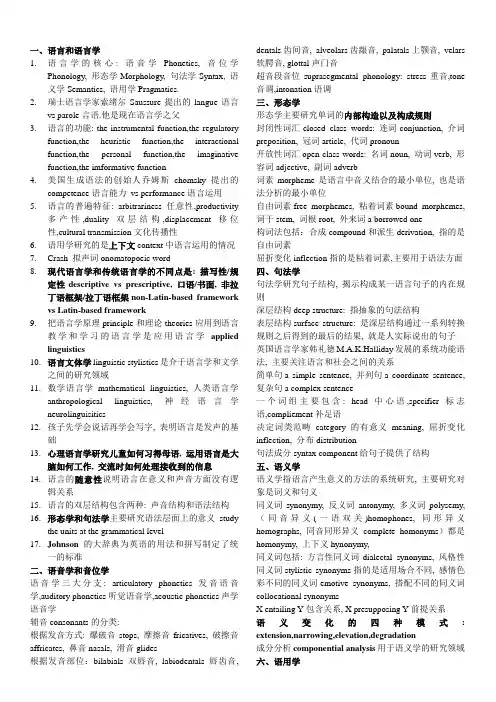
一、语言和语言学1.语言学的核心: 语音学Phonetics, 音位学Phonology, 形态学Morphology, 句法学Syntax, 语义学Semantics, 语用学Pragmatics.2.瑞士语言学家索绪尔Saussure提出的langue语言vs parole言语.他是现在语言学之父3.语言的功能: the instrumental function,the regulatoryfunction,the heuristic function,the interactional function,the personal function,the imaginative function,the imformative function4.美国生成语法的创始人乔姆斯chomsky提出的competence语言能力vs performance语言运用5.语言的普遍特征: arbitrariness任意性,productivity多产性,duality双层结构,displacement移位性,cultural transmission文化传播性6.语用学研究的是上下文context中语言运用的情况7.Crash 拟声词onomatopoeic word8.现代语言学和传统语言学的不同点是: 描写性/规定性descriptive vs prescriptive, 口语/书面, 非拉丁语框架/拉丁语框架non-Latin-based framework vs Latin-based framework9.把语言学原理principle和理论theories应用到语言教学和学习的语言学是应用语言学applied linguistics10.语言文体学linguistic stylistics是介于语言学和文学之间的研究领域11.数学语言学mathematical linguistics, 人类语言学anthropological linguistics, 神经语言学neurolinguisitics12.孩子先学会说话再学会写字, 表明语言是发声的基础13.心理语言学研究儿童如何习得母语, 运用语言是大脑如何工作, 交流时如何处理接收到的信息14.语言的随意性说明语言在意义和声音方面没有逻辑关系15.语言的双层结构包含两种: 声音结构和语法结构16.形态学和句法学主要研究语法层面上的意义studythe units at the grammatical level17.Johnson 的大辞典为英语的用法和拼写制定了统一的标准二、语音学和音位学语音学三大分支: articulatory phonetics发音语音学,auditory phonetics听觉语音学,acoustic phonetics声学语音学辅音consonants的分类:根据发音方式: 爆破音stops, 摩擦音fricatives, 破擦音affricates, 鼻音nasals, 滑音glides根据发音部位:bilabials双唇音, labiodentals唇齿音, dentals齿间音, alveolars齿龈音, palatals上颚音, velars 软腭音, glottal声门音超音段音位suprasegmental phonology: stress重音,tone 音调,intonation语调三、形态学形态学主要研究单词的内部构造以及构成规则封闭性词汇closed class words: 连词conjunction, 介词preposition, 冠词article, 代词pronoun开放性词汇open class words: 名词noun, 动词verb, 形容词adjective, 副词adverb词素morpheme是语言中音义结合的最小单位, 也是语法分析的最小单位自由词素free morphemes, 粘着词素bound morphemes, 词干stem, 词根root, 外来词a borrowed one构词法包括:合成compound和派生derivation, 指的是自由词素屈折变化inflection指的是粘着词素,主要用于语法方面四、句法学句法学研究句子结构, 揭示构成某一语言句子的内在规则深层结构deep structure: 指抽象的句法结构表层结构surface structure: 是深层结构通过一系列转换规则之后得到的最后的结果, 就是人实际说出的句子英国语言学家韩礼德M.A.K.Halliday发展的系统功能语法, 主要关注语言和社会之间的关系简单句a simple sentence, 并列句a coordinate sentence, 复杂句a complex sentence一个词组主要包含: head中心语,specifier标志语,compliement补足语决定词类范畴category的有意义meaning, 屈折变化inflection, 分布distribution句法成分syntax component给句子提供了结构五、语义学语义学指语言产生意义的方法的系统研究, 主要研究对象是词义和句义同义词synonymy, 反义词antonymy, 多义词polysemy, (同音异义(一语双关)homophones, 同形异义homographs, 同音同形异义complete homonyms)都是homonymy, 上下义hynonymy,同义词包括: 方言性同义词dialectal synonyms, 风格性同义词stylistic synonyms指的是适用场合不同, 感情色彩不同的同义词emotive synonyms, 搭配不同的同义词collocational synonymsX entailing Y包含关系, X presupposing Y前提关系语义变化的四种模式: extension,narrowing,elevation,degradation成分分析componential analysis用于语义学的研究领域六、语用学英国哲学家John.Austin发明了言语行为理论speech act theory区分语义学和语用学的最本质因素是是否考虑了语言使用过程中的语境言语行为的三种次行为: 言内行为locutionary, 言外行为illocutionary, 言后行为perlocutionary act美国哲学语言学家john searle约翰舍尔把言外行为分为五大类: representative描述性功能, directive指示性功能(包括invitng,suggesting,requesting,advising,warning,threatening ,ordering), commissive承担性功能, expressive表达性功能, declarative宣告性功能美国哲学家格莱斯Grice认为言语交际要包含以下四条准则:数量准则quantity maxim, 质量准则quality maxim, 关联准则relation maxim, 方式准则manner maxim情境因素contextual features包括时间, 地点和参与人, 不包括目的。
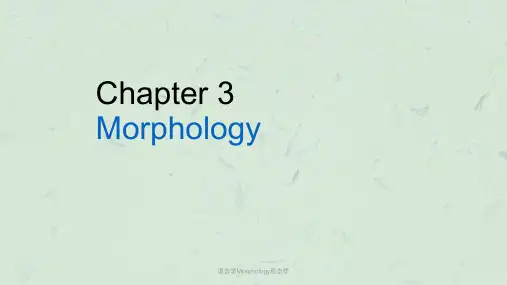
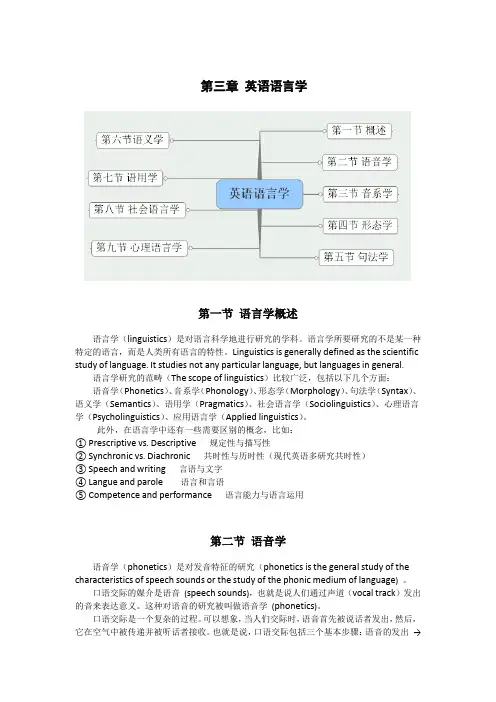
第三章英语语言学第一节语言学概述语言学(linguistics)是对语言科学地进行研究的学科。
语言学所要研究的不是某一种特定的语言,而是人类所有语言的特性。
Linguistics is generally defined as the scientific study of language. It studies not any particular language,but languages in general.语言学研究的范畴(The scope of linguistics)比较广泛,包括以下几个方面:语音学(Phonetics)、音系学(Phonology)、形态学(Morphology)、句法学(Syntax)、语义学(Semantics)、语用学(Pragmatics)、社会语言学(Sociolinguistics)、心理语言学(Psycholinguistics)、应用语言学(Applied linguistics)。
此外,在语言学中还有一些需要区别的概念,比如:① Prescriptive vs. Descriptive规定性与描写性② Synchronic vs. Diachronic共时性与历时性(现代英语多研究共时性)③ Speech and writing言语与文字④ Langue and parole语言和言语⑤ Competence and performance语言能力与语言运用第二节语音学语音学(phonetics)是对发音特征的研究(phonetics is the general study of the characteristics of speech sounds or the study of the phonic medium of language) 。
口语交际的媒介是语音(speech sounds),也就是说人们通过声道(vocal track)发出的音来表达意义。
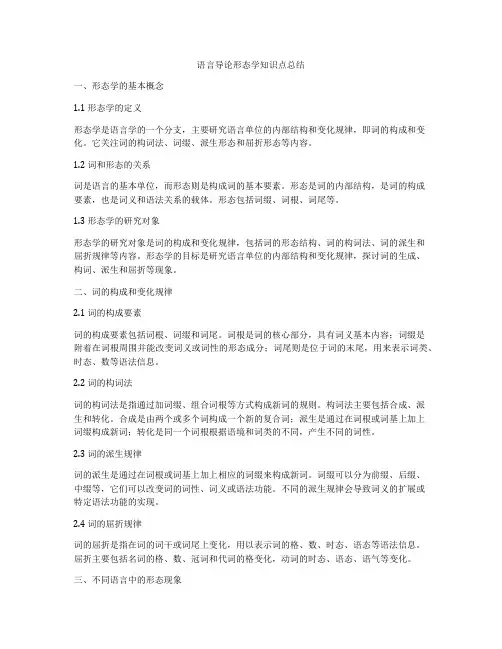
语言导论形态学知识点总结一、形态学的基本概念1.1 形态学的定义形态学是语言学的一个分支,主要研究语言单位的内部结构和变化规律,即词的构成和变化。
它关注词的构词法、词缀、派生形态和屈折形态等内容。
1.2 词和形态的关系词是语言的基本单位,而形态则是构成词的基本要素。
形态是词的内部结构,是词的构成要素,也是词义和语法关系的载体。
形态包括词缀、词根、词尾等。
1.3 形态学的研究对象形态学的研究对象是词的构成和变化规律,包括词的形态结构、词的构词法、词的派生和屈折规律等内容。
形态学的目标是研究语言单位的内部结构和变化规律,探讨词的生成、构词、派生和屈折等现象。
二、词的构成和变化规律2.1 词的构成要素词的构成要素包括词根、词缀和词尾。
词根是词的核心部分,具有词义基本内容;词缀是附着在词根周围并能改变词义或词性的形态成分;词尾则是位于词的末尾,用来表示词类、时态、数等语法信息。
2.2 词的构词法词的构词法是指通过加词缀、组合词根等方式构成新词的规则。
构词法主要包括合成、派生和转化。
合成是由两个或多个词构成一个新的复合词;派生是通过在词根或词基上加上词缀构成新词;转化是同一个词根根据语境和词类的不同,产生不同的词性。
2.3 词的派生规律词的派生是通过在词根或词基上加上相应的词缀来构成新词。
词缀可以分为前缀、后缀、中缀等,它们可以改变词的词性、词义或语法功能。
不同的派生规律会导致词义的扩展或特定语法功能的实现。
2.4 词的屈折规律词的屈折是指在词的词干或词尾上变化,用以表示词的格、数、时态、语态等语法信息。
屈折主要包括名词的格、数、冠词和代词的格变化,动词的时态、语态、语气等变化。
三、不同语言中的形态现象3.1 中国语言的形态现象汉语是一个以词汇和语序为主要特征的语言,形态变化比较简单。
汉语的词构成多采用词素的复合方式,如“书店”、“教室”等。
此外,汉语还有一些词缀和词类标志,如“了”、“的”等。
3.2 英语的形态现象英语是一种屈折语言,动词、名词、形容词等在词形上会发生变化。
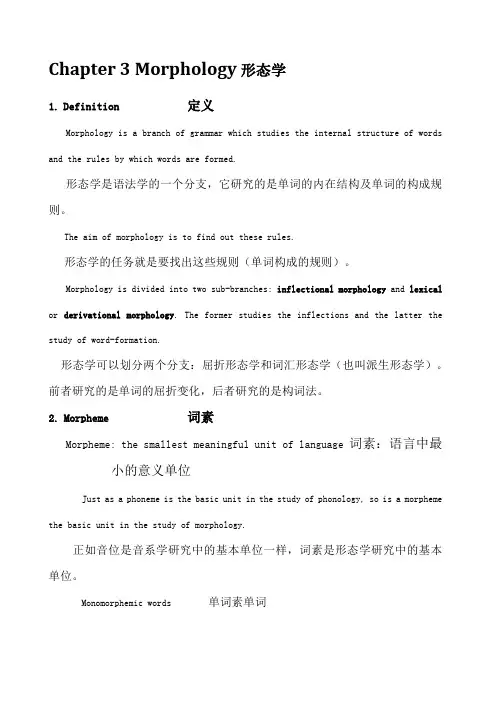
Chapter 3 Morphology 形态学1.Definition 定义Morphology is a branch of grammar which studies the internal structure of words and the rules by which words are formed.形态学是语法学的一个分支,它研究的是单词的内在结构及单词的构成规则。
The aim of morphology is to find out these rules.形态学的任务就是要找出这些规则(单词构成的规则)。
Morphology is divided into two sub-branches: inflectional morphology and lexical or derivational morphology. The former studies the inflections and the latter the study of word-formation.形态学可以划分两个分支:屈折形态学和词汇形态学(也叫派生形态学)。
前者研究的是单词的屈折变化,后者研究的是构词法。
2.Morpheme 词素Morpheme: the smallest meaningful unit of language 词素:语言中最小的意义单位Just as a phoneme is the basic unit in the study of phonology, so is a morpheme the basic unit in the study of morphology.正如音位是音系学研究中的基本单位一样,词素是形态学研究中的基本单位。
Monomorphemic words 单词素单词Types of morphemes 词素的类型Free morphemes 自由词素The morphemes that are independent units of meaning and can be used freely all by themselves are called free morphemes. Such as help, table,room, mate, quick, able.这些词素是独立的、可以自由使用的意义单位,所以它们就被称作自由词素。
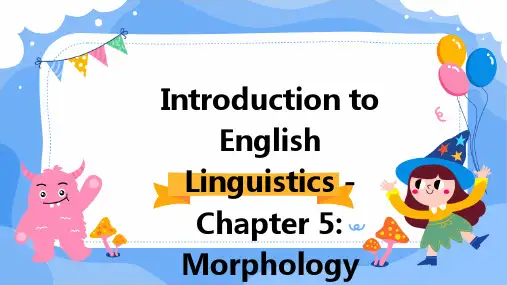
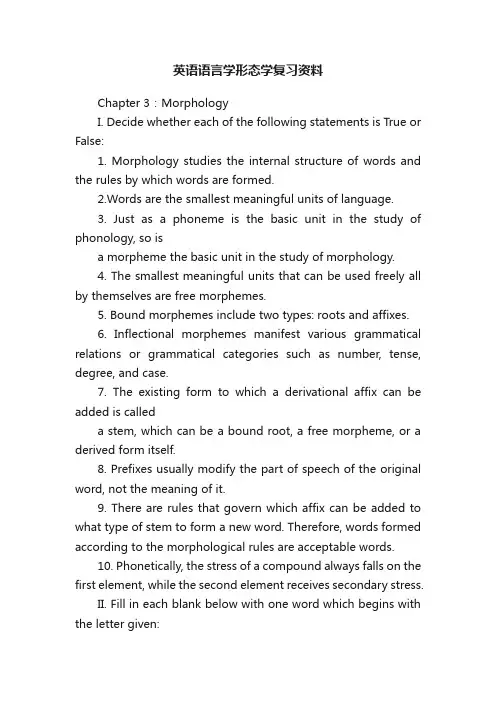
英语语言学形态学复习资料Chapter 3:MorphologyI. Decide whether each of the following statements is True or False:1. Morphology studies the internal structure of words and the rules by which words are formed.2.Words are the smallest meaningful units of language.3. Just as a phoneme is the basic unit in the study of phonology, so isa morpheme the basic unit in the study of morphology.4. The smallest meaningful units that can be used freely all by themselves are free morphemes.5. Bound morphemes include two types: roots and affixes.6. Inflectional morphemes manifest various grammatical relations or grammatical categories such as number, tense, degree, and case.7. The existing form to which a derivational affix can be added is calleda stem, which can be a bound root, a free morpheme, or a derived form itself.8. Prefixes usually modify the part of speech of the original word, not the meaning of it.9. There are rules that govern which affix can be added to what type of stem to form a new word. Therefore, words formed according to the morphological rules are acceptable words.10. Phonetically, the stress of a compound always falls on the first element, while the second element receives secondary stress.II. Fill in each blank below with one word which begins with the letter given:11. M ____ is the smallest meaningful unit of language.12. The affix “-ish” in the word boyish conveys a g____ meaning.13. B___________ morphemes are those that cannot be used independently but have to be combined with other morphemes, either free or bound, to form a word.14. Affixes are of two types: inflectional affixes and d__________ affixes.15. D________ affixes are added to an existing form to create words.16. A s______ is added to the end of stems to modify the meaning of the original word and it may case change its part of speech.17. C__________ is the combination of two or sometimes more than two words to create new words.18. The rules that govern which affix can be added to what type of stem to form a new word are called m___________ rules.19. In terms of morphemic analysis, d_______________ can be viewed as the addition of affixes to stems to form new words.20. A s______ can be a bound root, a free morpheme, or a derived form itself to which a derivational affix can be added.III. There are four choices following each statement. Mark the choice that can best complete the statement:21. The morpheme “vision” in the common word “television” is a(n)______.A. bound morphemeB. bound formC. inflectional morphemeD. free morpheme22. The compound word “bookstore” is the place where books are sold.This indicates that the meaning of a compound __________.A. is the sum total of the meaning of its componentsB. can always be worked out by looking at the meanings of morphemesC. is the same as the meaning of a free phrase.D. None of the above.23. The part of speech of the compounds is generally determined by thepart of speech of __________.A. the first elementB. the second elementC. either the first or the second elementD. both the first and the second elements.24. _______ are those that cannot be used independently but have to becombined with other morphemes, either free or bound, to form a word.A. Free morphemesB. Bound morphemesC. Bound wordsD. Words25. _________ is a branch of grammar which studies the internalstructure of words and the rules by which words are formed.A. SyntaxB.GrammarC. MorphologyD. Morpheme26. The meaning carried by the inflectional morpheme is _______.A. lexicalB. morphemicC. grammaticalD. semantic27. Bound morphemes are those that ___________.A. have to be used independentlyB. can not be combined with other morphemesC. can either be free or boundD. have to be combined with other morphemes.28. ____ modify the meaning of the stem, but usually do not change thepart of speech of the original word.A. PrefixesB. SuffixesC. RootsD. Affixes29. _________ are often thought to be the smallest meaningful unitsof language by the linguists.A. WordsB. MorphemesC. PhonemesD. Sentences30. “-s” in the word “books” is _______.A. a derivative affixB. a stemC. an inflectional affixD. a rootIV. Define the following terms:31. morphology 32. inflectional morphology33. derivational morphology 34. morpheme35. free morpheme 36. bound morpheme37. root 38. affix39. prefix 40. suffix41. derivation 42. CompoundingV. Answer the following questions:43. What are the main features of the English compounds?44. Discuss the types of morphemes with examples.I. Decide whether each of the following statements is True or False:l.T 2.F 3.T 4.T 5.T 6.T 7.T 8.F 9.F 10.TII. II. Fill in each blank below with one word which begins with the letter given:11. Morpheme 12. grammatical 13. Bound 14. derivative 15.Derivative 16. suffix 17. Compounding 18. morphological 19. derivation 20. stem III. There are four choices following each statement. Mark the choice that can best complete the statement: 2l.D 22.D 23.B 24.B 25.C 26. C 27. D 28. A 29. B 30. C IV. Define the following terms:31. Morphology: Morphology is a branch of grammar which studies theinternal structure of words and the rules by which words are formed.32. inflectional morphology: The inflectional morphology studies the inflections33. derivational morphology: Derivational morphology is the study ofword- formation.34. Morpheme: It is the smallest meaningful unit of language.35. free morpheme: Free morphemes are the morphemes which areindependent units of meaning and can be used freely all by themselves or in combination with other morphemes.36. bound morpheme: Bound morphemes are the morphemes which cannotbe used independently but have to be combined with other morphemes, either free or bound, to form a word.37. Root: A root is often seen as part of a word; it can never standby itself although it bears clear, definite meaning; it must be combined with another root or an affix to form a word.38. Affix: Affixes are of two types: inflectional and derivational.Inflectional affixes manifest various grammatical relations or grammatical categories, while derivational affixes are added to an existing form to create a word.39. Prefix: Prefixes occur at the beginning of a word . Prefixes modifythe meaning of the stem, but they usually do not change the part of speech of the original word.40. Suffix: Suffixes are added to the end of the stems; they modifythe meaning of the original word and in many cases change its part of speech.41. Derivation:Derivation is a process of word formation by whichderivative affixes are added to an existing form to create a word.42. Compounding: Compounding can be viewed as the combination of twoor sometimes more than two words to create new words.V. Anwser the following questions:43. What are the main features of the English compounds?Orthographically a compound can be written as one word, two separate words with or without a hyphen in between. Syntactically, the part of speech of a compound is determined by the last element. Semantically, the meaning of a compound is idiomatic, not calculable from the meanings of all its components. Phonetically, the word stress of a compound usually falls on the first element.44. Discuss the types of morphemes with examples.Free morphemes: They are the independent units of meaning and can beused freely all by themselves, for example, “book-” in the word “bookish”.Bound morphemes: They are those that cannot be used independently but have to be combined with other morphemes, either free or bound, to form a word such as “-ish” in “bookish”. Bound morphemes can be subdivided into roots and affixes. A root is seen as part of a word; it can never stand by itself although it has a clear and definite meaning, such as “gene-” in the word “generate”. Affixes are of two types: inflectional and derivational. Inflectional morphemes manifest various grammatical relations or grammati cal categories such as “-s” in the word “books” to indicate plurality of noun s. Derivational affixes are added to an existing form to create a word such as “mis-” in the word “misinform”. Derivational affixes can also be divided into prefixes and suffixes. Prefixesoccur at the beginning of a word such as “dis- ” in the word “dislike”, while suffixes occur at the end of a word such as “-less” in the word “friendless”.。
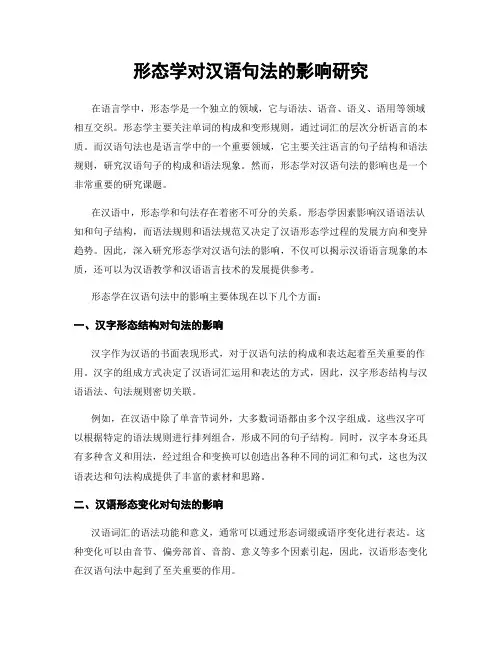
形态学对汉语句法的影响研究在语言学中,形态学是一个独立的领域,它与语法、语音、语义、语用等领域相互交织。
形态学主要关注单词的构成和变形规则,通过词汇的层次分析语言的本质。
而汉语句法也是语言学中的一个重要领域,它主要关注语言的句子结构和语法规则,研究汉语句子的构成和语法现象。
然而,形态学对汉语句法的影响也是一个非常重要的研究课题。
在汉语中,形态学和句法存在着密不可分的关系。
形态学因素影响汉语语法认知和句子结构,而语法规则和语法规范又决定了汉语形态学过程的发展方向和变异趋势。
因此,深入研究形态学对汉语句法的影响,不仅可以揭示汉语语言现象的本质,还可以为汉语教学和汉语语言技术的发展提供参考。
形态学在汉语句法中的影响主要体现在以下几个方面:一、汉字形态结构对句法的影响汉字作为汉语的书面表现形式,对于汉语句法的构成和表达起着至关重要的作用。
汉字的组成方式决定了汉语词汇运用和表达的方式,因此,汉字形态结构与汉语语法、句法规则密切关联。
例如,在汉语中除了单音节词外,大多数词语都由多个汉字组成。
这些汉字可以根据特定的语法规则进行排列组合,形成不同的句子结构。
同时,汉字本身还具有多种含义和用法,经过组合和变换可以创造出各种不同的词汇和句式,这也为汉语表达和句法构成提供了丰富的素材和思路。
二、汉语形态变化对句法的影响汉语词汇的语法功能和意义,通常可以通过形态词缀或语序变化进行表达。
这种变化可以由音节、偏旁部首、音韵、意义等多个因素引起,因此,汉语形态变化在汉语句法中起到了至关重要的作用。
例如,在汉语中,一个单音节词汇可以通过添加不同的语素,派生出多个意义不同的词,如“学”可以派生出“学生”、“学问”、“学习”等多个相关的词汇,这种派生过程既反映了词汇的发展演变史,也为汉语句法提供了更为丰富的表达形式。
另一方面,在汉语语法中,形态词缀和语序变化也可以产生不同的语法含义,例如在动词中,“了”、“在”、“过”等语素的加减,可以改变动词的语态和时态,反映不同的情态语气。
一、定义:什么是语言学?Linguistics is generally defined as the scientific study of language.二、语言学研究的核心(下面的术语要尽量全都认识,不然做题时可能看不懂选项)1、Phonetics 语音学2、Phonology 音位学3、Morphology 形态学4、Syntax 句法学5、Semantics 语义学6、Pragmatics 语用学三、语言(Langue)和言语(Parole)这个考过的。
Parole这个概念是F. de Saussure(索绪尔)提出的。
Langue指语言系统的整体,“所有(语言使用)个体头脑中存储的词语-----形象之总和”,这个整体相对较为稳定;Parole指某个个体在实际语言使用环境中说出的具体话语,它是随时间和地点变化的一个动态的实体。
四、语言的功能Functions of Language(这个也考过的。
考过the informative function,就是高速公路指示牌的那道题)1、The instrumental function2、The regulatory function3、The heuristic function4、The interactional function5、The personal function6、The imaginative function7、The informative function五、语言的普遍特征Design Features这个也考过的,这五个特征由美国语言学家Charles Hockett提出。
弱弱地说一句:如果真的在临时抱佛脚,那就不要管这五个术语的具体含义了,只要能强行记下来应付考试就是了。
>_<1、Arbitrariness 任意性2、Productivity 多产性3、Duality 双层结构4、Displacement 移位性5、Cultural Transmission 文化传播性六、语音学和音位学(一)语音学Phonetics: the study of the phonic medium of language.1、三大分支(1)Articulatory Phonetics发音语音学(2)Auditory Phonetics 听觉语音学(3)Acoustic Phonetics 声学语音学2、辅音和元音(这个考过的,考过二者的区别)(二)音位学Phonology: aims to discover how speech sounds in a language form pattern and how these sounds are used to convey meaning in linguistic communication.1、三个术语(1)Phone音素(2)Phoneme音位(3)Allophone音位变体2、Suprasegmental Phonology超音段音位(考过的)包括Stress重音、Tone音调、Intonation语调七、形态学Morphology: refers to the study of the internal structure of words, and the rules by which words are formed.(一)两类词汇1、Closed class words封闭性词汇2、Open class words开放性词汇(二)Morpheme词素1、Free morpheme自由词素2、Bound morpheme粘着词素3、Stem词干4、Root词根(三)Word-formation构词法(四)Inflection屈折变化八、句法学Syntax: studies how words are combined to form sentences and the rules that govern the formation of sentences.九、语义学Semantics: is generally considered to be the study of meaning in language.1、Synonymy同义关系2、Polysemy一词多义3、Homophones同音异义&Homogragh同形异义&Complete homonyms同形同音异义4、Hyponymy上下义关系5、Antonymy反义关系6、Analysis of meaning语义分析(1)Componential analysis成分分析(2)Predication analysis述谓分析7、 Two-place predicate二向谓词、one-place predicate一向谓词、no-place predicate 零向谓词8、 Sense relations between sentences(1)Entailment(2)Presupposition十、语用学1、Pragmatics: the study of how speakers of a language use sentences to effect successful communication. (Or it refers to the study of natural language understanding, and specifically the study of how context influences the interpretation of meanings.)2、区分语义学和语用学的最本质因素是:是否考虑了语言使用过程中的语境。
形态学与词法学的基本概念形态学是语言学的一个分支,研究词的内部结构、形态变化以及词的构词规则。
而词法学则关注词汇的意义和用法,研究词的分类、词义的构成和词的用法规则。
本文将介绍形态学与词法学的基本概念,包括词、词的内部结构、词的分类和词义的构成等。
一、词的基本概念词是语言中的基本单位,是表达某个意义的最小语言单位。
在形态学和词法学中,词被视为一种形式或几种形式的组合,它具有语义上的完整性。
词的构成可以通过单个词素或多个词素的组合来实现。
二、词的内部结构词的内部结构指的是词的构成方式,主要包括词素和词的形态变化。
词素是指具有独立意义的最小语言单位,可以是单个字或由多个字构成的词根、前缀、后缀等。
形态变化是指词在不同语法环境中发生的变化,包括屈折变化和派生变化。
三、词的分类词的分类可以根据不同的分类标准进行,包括词性、词类、词义等。
按照词性分类,词可以分为名词、动词、形容词、副词、介词、连词等。
按照词类分类,词可以分为实词和虚词。
实词具有实际意义,包括名词、动词、形容词等;虚词则具有辅助性质,包括介词、连词、助词等。
按照词义分类,词可以分为同义词、反义词、近义词等。
四、词义的构成词义的构成是指词由基本义和引申义组成的过程。
基本义是词最原始的意义,引申义则是通过隐喻、类比等方式产生的衍生意义。
引申义可以使词的意义更加丰富,为表达丰富多样的语言信息提供了便利。
五、形态学与词法学的关系形态学和词法学是紧密相关的学科领域。
形态学主要关注词的形态变化和构词规则,研究词的内部结构;而词法学则关注词的意义和用法,研究词的分类和词义的构成。
两者相互补充,共同构成了对语言词汇系统进行系统研究的基础。
综上所述,形态学与词法学是语言学中重要的研究方向,它们对于理解和分析词的结构、形态变化和词义构成具有重要意义。
通过对形态学和词法学的研究,可以更好地理解和应用语言,为语言教学、翻译和语言技术的发展提供理论支持和实践指导。